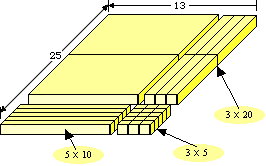| Assume you are trying to find the LCM of 4 and 6. Start by creating several "trains" of blocks 4 singles long and several which are 6 singles in length. |
|
Place these trains along the edge of the cm ruler starting at 0. Every place where one of the trains ends represents a multiple of that number. You will find that the multiples of 4 are 4, 8, 12, 16, 20, ... and the multiples of 6 are 6, 12, 18, 24, 30 ... Wherever the trains end at the same spot represents a "common" multiple. The first such instance is the "least" common multiple. A diagram is shown below. The least common multiple of 4 and 6 is 12. |
| How could you model the "greatest common factor"? |




